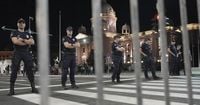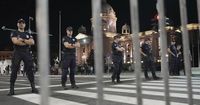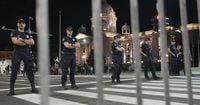Tens of thousands of anti-government protesters filled the streets of Serbia on Monday, September 1, 2025, marking a pivotal moment in a movement that has gripped the Balkan nation for nearly a year. The demonstrators, led primarily by high school and university students, converged in the capital city of Belgrade and several other towns, including Novi Sad, to demand sweeping political changes and accountability from President Aleksandar Vucic’s government. Their calls echoed the outrage sparked ten months ago, when a concrete canopy collapsed at a train station in Novi Sad, killing 16 people—a tragedy widely blamed on state corruption and negligence.
According to the Associated Press, the protests on Monday were the latest in a series of mass mobilizations that have surged since the Novi Sad disaster. The collapse, which many believe could have been prevented with proper oversight, has become a symbol of deeper grievances against the government. Protesters cite not just the loss of life, but a broader culture of impunity, lack of transparency, and the stifling of dissent that has characterized President Vucic’s increasingly populist rule.
Shielded riot police, some backed by paramilitary loyalists, formed tight cordons in downtown Belgrade, particularly in front of Vucic’s headquarters—a site that has served as a flashpoint for months. The heavy security presence underscored the government’s determination to control the narrative and prevent demonstrators from gaining ground. In Novi Sad, the scene turned tense as baton-wielding police charged at peaceful protesters, resulting in minor injuries, according to local news portals referenced by the Los Angeles Times.
Despite these confrontations, the mood among protesters was resolute. Their demands have remained consistent and clear: early elections, transparent investigations into the canopy collapse, criminal prosecutions for those deemed responsible, and the restoration of free, independent media. Many participants see these issues as fundamentally intertwined, representing a struggle for the soul of Serbia’s democracy.
“I think this fight will not be over soon,” said Anabela Arsenovic, a student who has emerged as one of the protest voices. “There are months ahead of us fighting, but I hope it will [end] at some point and the elections will be held.” Her words, reported by the Associated Press, capture both the exhaustion and the determination fueling the movement.
The government’s response has been swift and severe. In a move that has drawn widespread condemnation, more than one hundred university and high school professors were dismissed from their positions after expressing support for the student-led protests. These educators, seen as pillars of intellectual and civic life, were replaced by loyalists handpicked by Vucic’s administration. Critics argue that this purge is part of a broader effort to suppress dissent and silence those who challenge the official line.
Meanwhile, President Vucic has not hesitated to use incendiary language, branding the protesters as “terrorists who want to unseat him from power.” This accusation, reported by both the Associated Press and the Los Angeles Times, has further inflamed tensions and deepened the divide within Serbian society. For many, the president’s rhetoric is emblematic of an administration that brooks no opposition and seeks to delegitimize any challenge to its authority.
The timing of Monday’s protest was notable. As crowds gathered in Belgrade and beyond, Vucic was traveling to China for a high-profile summit. The gathering included Russian President Vladimir Putin, leaders from China, India, Belarus, and Iran, highlighting Serbia’s complex foreign policy balancing act. While Vucic has publicly stated his desire to steer Serbia toward European Union membership, his participation in such forums underscores his efforts to maintain strong ties with both Eastern and Western powers.
This international context has not been lost on protest organizers, who argue that Serbia’s aspirations for EU membership are incompatible with the current government’s authoritarian tendencies. They point to the crackdown on academic freedom, the muzzling of independent media, and the violent suppression of peaceful demonstrations as evidence that the country is drifting away from European norms.
Divisions within Serbia have only grown sharper in recent weeks. On Sunday, August 31, 2025, just one day before the latest wave of anti-government demonstrations, thousands of Vucic’s supporters marched in several towns across the country. Their rallies, covered by the Associated Press, were intended to project strength and unity behind the president, but also served as a stark reminder of the deep polarization that now defines Serbian politics.
Supporters of the government argue that Vucic has brought stability and economic growth to Serbia, and that the protests are orchestrated by foreign interests seeking to destabilize the country. They point to the president’s diplomatic outreach and investment in infrastructure as signs of progress, and dismiss the opposition’s claims as exaggerated or politically motivated.
On the other side, critics contend that Vucic’s brand of populism has eroded democratic institutions and concentrated power in the hands of a loyal elite. The firing of professors, the deployment of riot police, and the branding of dissenters as terrorists, they argue, are tactics more befitting an autocracy than a democracy aspiring to join the European Union.
For many ordinary Serbians, the stakes could hardly be higher. The memory of the Novi Sad tragedy remains fresh, and the sense of injustice it provoked has not faded. Protesters see their struggle as not only about accountability for a single disaster, but as part of a broader fight for transparency, justice, and a voice in the country’s future.
As the protests continue, the outcome remains uncertain. Will the government yield to demands for early elections and genuine investigations? Or will it double down on repression and rhetoric, betting that public fatigue will eventually sap the movement’s momentum? For now, the only certainty is that Serbia stands at a crossroads, with its citizens determined to shape what comes next.
In the shadow of the Novi Sad collapse and amid the swirl of international diplomacy, the voices of Serbia’s students and their supporters ring out—demanding not just answers, but a new direction for their country.




